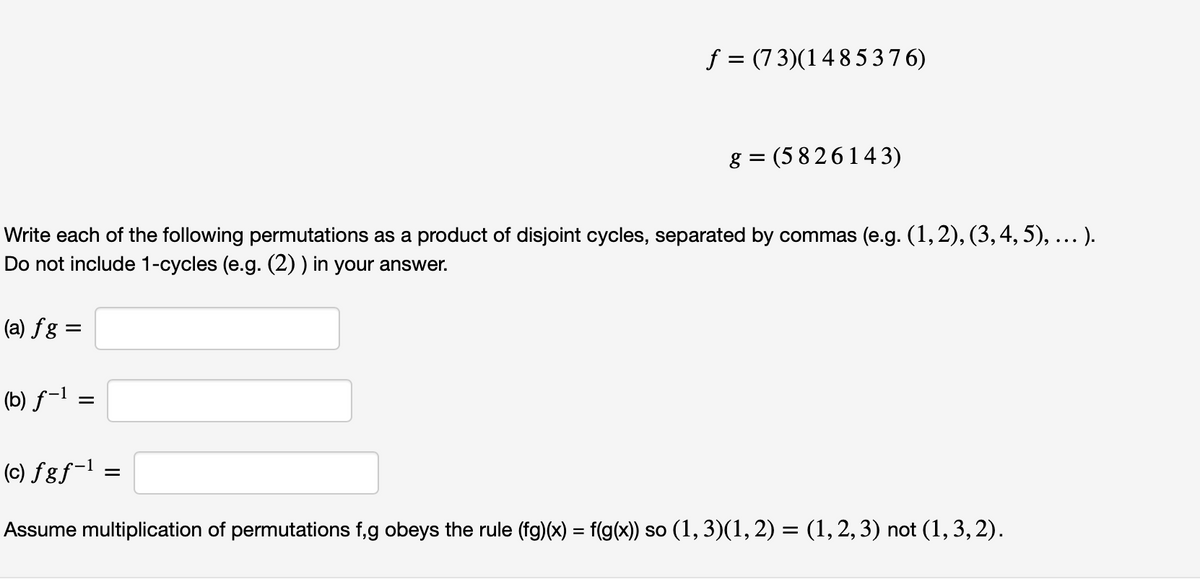f = (7 3)(14 85 37 6) g = (5 8 26143) Write each of the following permutations as a product of disjoint cycles, separated by commas (e.g. (1,2), (3, 4, 5), ... ). Do not include 1-cycles (e.g. (2) ) in your answer. (a) fg = (b) ƒ-1 (c) fgƒ¬l = Assume multiplication of permutations f,g obeys the rule (fg)(x) = f(g(x) so (1, 3)(1, 2) = (1, 2, 3) not (1, 3, 2).
f = (7 3)(14 85 37 6) g = (5 8 26143) Write each of the following permutations as a product of disjoint cycles, separated by commas (e.g. (1,2), (3, 4, 5), ... ). Do not include 1-cycles (e.g. (2) ) in your answer. (a) fg = (b) ƒ-1 (c) fgƒ¬l = Assume multiplication of permutations f,g obeys the rule (fg)(x) = f(g(x) so (1, 3)(1, 2) = (1, 2, 3) not (1, 3, 2).
Algebra & Trigonometry with Analytic Geometry
13th Edition
ISBN:9781133382119
Author:Swokowski
Publisher:Swokowski
Chapter10: Sequences, Series, And Probability
Section10.7: Distinguishable Permutations And Combinations
Problem 16E
Related questions
Question
Let f and g be permutations on the set {1,2,3,4,5,6,7,8}{1,2,3,4,5,6,7,8}, defined as follows

Transcribed Image Text:f = (7 3)(148537 6)
g = (5 8 26143)
Write each of the following permutations as a product of disjoint cycles, separated by commas (e.g. (1,2), (3,4, 5), ... ).
Do not include 1-cycles (e.g. (2) ) in your answer.
(a) fg =
(b) ƒ-l =
(c) fgƒ-l =
Assume multiplication of permutations f,g obeys the rule (fg)(x) = f(g(x) so (1, 3)(1, 2) = (1,2,3) not (1, 3,2).
Expert Solution
This question has been solved!
Explore an expertly crafted, step-by-step solution for a thorough understanding of key concepts.
Step by step
Solved in 2 steps

Recommended textbooks for you

Algebra & Trigonometry with Analytic Geometry
Algebra
ISBN:
9781133382119
Author:
Swokowski
Publisher:
Cengage

Elements Of Modern Algebra
Algebra
ISBN:
9781285463230
Author:
Gilbert, Linda, Jimmie
Publisher:
Cengage Learning,

Linear Algebra: A Modern Introduction
Algebra
ISBN:
9781285463247
Author:
David Poole
Publisher:
Cengage Learning

Algebra & Trigonometry with Analytic Geometry
Algebra
ISBN:
9781133382119
Author:
Swokowski
Publisher:
Cengage

Elements Of Modern Algebra
Algebra
ISBN:
9781285463230
Author:
Gilbert, Linda, Jimmie
Publisher:
Cengage Learning,

Linear Algebra: A Modern Introduction
Algebra
ISBN:
9781285463247
Author:
David Poole
Publisher:
Cengage Learning